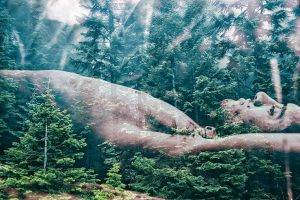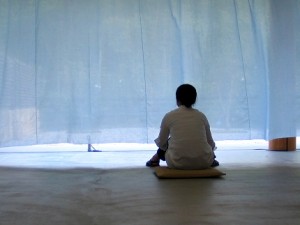 Our Moving into Meditation class continues to draw inspiration from The Five Invitations, Frank Ostaseski’s wonderful book about living with the awareness that we’re going to die. His book distills what he’s learned into Five Invitations we can answer in living a conscious life in connection with each other. In today’s class we explored the fourth invitation: to find a place of rest in the middles of things. Frank advises that: “. . . If we hope to find true rest, we need to see clearly the currents that disturb us. . . To make real change, we have to dive deeper to understand the specific ways that we’ve been conditioned throughout our lives.” Our mindfulness practice offers us the time and space to understand our conditioning and how it drives us to distress.
Our Moving into Meditation class continues to draw inspiration from The Five Invitations, Frank Ostaseski’s wonderful book about living with the awareness that we’re going to die. His book distills what he’s learned into Five Invitations we can answer in living a conscious life in connection with each other. In today’s class we explored the fourth invitation: to find a place of rest in the middles of things. Frank advises that: “. . . If we hope to find true rest, we need to see clearly the currents that disturb us. . . To make real change, we have to dive deeper to understand the specific ways that we’ve been conditioned throughout our lives.” Our mindfulness practice offers us the time and space to understand our conditioning and how it drives us to distress.
Guided Relaxation
Welcome . . . to this time of simply being . . . take refuge in your senses . . . feeling breathing . . . vibrations of sound . . . arising . . . subsiding sensations . . . explore what it is to truly let go . . . allowing yourself to be truly nourished by the breath . . . trusting the miracle of continuous life . . . your heart beat . . . the energies of all the metabolic processes sustaining you . . . breaking down and building up . . . allowing you to grow . . . enveloping skin . . . muscles . . . tendons . . . bones . . . these life enabling processes enabled by breath, food, water and also rest . . .
 These moments of rest are truly precious. They allow us to restore our spent energies and to free ourselves from the distractions that often cloud our perception. In pausing and giving ourselves this time we begin to feel the currents that flow under our busy lives . . . the deeper emotions – often unconscious – that motivate our actions and inform the ways we see ourselves and others.
These moments of rest are truly precious. They allow us to restore our spent energies and to free ourselves from the distractions that often cloud our perception. In pausing and giving ourselves this time we begin to feel the currents that flow under our busy lives . . . the deeper emotions – often unconscious – that motivate our actions and inform the ways we see ourselves and others.
In Frank O.’s book, The Five Invitations, he writes that many of these unconscious waves take the form of craving, aversion and ignorance . . . the forces that keep us racing either toward or away from what is present right now. We sometimes feel the urgency of our demands, the unpleasant energy of our dislikes and the absent quality of our distractions. It is so easy to perpetuate the cycle to avoid what doesn’t feel good or what we don’t want to see. He writes:
“. . . inherent in demand is the notion that what is here now, what we have now, isn’t good enough. We can sense this drive for more in our bodies as an energetic pull, the desperate wanting for something to fill up our underlying sense of deficiency. . . “ Perhaps you can feel the continuing vibrations of this pull right now . . . and also know you can breathe deeply and hear your inner voice remind you: “I am here now. We are here now.”
 “ . . . defense . . . can show up as anger, hatred, bullying, loneliness, intolerance or fear. We habitually resist, deny and avoid unpleasant feelings, circumstances and people . . . It reinforces our mistaken perceptions that we are separate from everything and everyone. Energetically, we know this drive in our bodies as . . . a pushing away. . . . “ Together we can breathe deeply and hear: “I am here now. We are here now.”
“ . . . defense . . . can show up as anger, hatred, bullying, loneliness, intolerance or fear. We habitually resist, deny and avoid unpleasant feelings, circumstances and people . . . It reinforces our mistaken perceptions that we are separate from everything and everyone. Energetically, we know this drive in our bodies as . . . a pushing away. . . . “ Together we can breathe deeply and hear: “I am here now. We are here now.”
“The ignorance of distraction . . . blinds us to the way reality works . . . We misperceive the nature of things, which is that they are both interdependent and impermanent. Alcohol, shopping, eating, gambling, sex, social media . . . serve as habits and strategies for distracting ourselves . . . Energetically we feel spaced out . . . vaguely unconscious.” Right now we break out of the fog and hear: “I am here now. We are here now.”
Right now we are taking the antidote of mindfulness. In the stillness and time of rest, feeling and healing happen. When we can truly feel these universal currents we begin to see them as our human condition. Frank reminds us that:
“Suffering is not random, nor is it a punishment for our personal failings or a sign of moral weakness. Suffering is the natural consequence of ignoring the truth of life’s ever changing causes & conditions. . . .”
He offers encouragement to engage with the obstacles on our path:
“. . . The missteps we make as we demand, defend and distract are also gateways to the innate beauty of our inner being. When we allow ourselves to rest in our natural openness, we can come to . . . recognize their detrimental impact on our lives. . . . We see our conditioning . . . with clear awareness . . . This is a moment of liberation. The truth that was obscured . . . now sets us free. . . . “
 We can cultivate healing, nurturing mind-states . . . growing our innate goodness – our qualities of generosity and gratitude . . . loving kindness and compassion. The energies of these states propel us to take loving action in the world. When we work with our minds we begin to see the causes and conditions of our challenges our reactivity becomes workable. In the depths of calm we can draw on our wisdom and compassion to form our response to life’s difficult moments. We can take refuge in these moments . . . we can create what Frank describes as the “ . . . warm, open and nonjudgmental space in which whatever needs to happen, can happen. . . . We can be that one calm person in the room. In doing so, we can be a true refuge to others.”
We can cultivate healing, nurturing mind-states . . . growing our innate goodness – our qualities of generosity and gratitude . . . loving kindness and compassion. The energies of these states propel us to take loving action in the world. When we work with our minds we begin to see the causes and conditions of our challenges our reactivity becomes workable. In the depths of calm we can draw on our wisdom and compassion to form our response to life’s difficult moments. We can take refuge in these moments . . . we can create what Frank describes as the “ . . . warm, open and nonjudgmental space in which whatever needs to happen, can happen. . . . We can be that one calm person in the room. In doing so, we can be a true refuge to others.”
Right now I invite you to . . . place . . . right hand on . . . heart, . . . left hand on . . . belly and hear inside . . . “I am here now. We are here now.”
Here and now is the only place of rest.
From John O’Donohue’s For One Who Is Exhausted, A Blessing:
 . . . Take refuge in your senses
. . . Take refuge in your senses
Open up to all the small miracles you rushed through . . .
Draw along the calmness of stone until its calmness can claim you
Be excessively gentle with yourself . . .
Gradually return to yourself having learned a new respect for your heart
and the joy that dwells for you within slow time . . .
